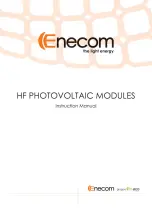
www.znshinesolar.com
Document No.
:
QES/ZX-RD-III032A
- 25
6
、
MODULE MAINTENANCE
In order to ensure the long-term using of the installed PV system and maximize the Power output
performance of the modules, the installed PV modules need to be inspected and maintained regularly. The
inspection and maintenance of modules in the PV array shall be carried out by personnel who have received
professional PV system maintenance training and obtained relevant qualifications and authorization.
6.1
、
PANEL VISUAL INSPECTION AND REPLACEMENT
The modules in a PV array should be regularly checked for damage. Factors such as glass breakage, cable
breakage, junction box damage and the terminals cannot be connected well may lead to function and safety
problems. In the case of a damaged module, replace it with the same type of module. Do not touch live parts of
cables and connectors. Use appropriate safety equipment (insulated tools, insulating gloves, etc.) when handling
modules. Refer to the appropriate Product Installation Manual for installation and disassembly of module.
Check the electrical, grounding and mechanical connections every 6 months to ensure they are clean and
safe, free from damage or rust. Check that all string fuses in each non/earthed pole are operating. Check that the
mounting parts are tight. Check all cables and make sure that the connectors are securely. PV modules frames
and bracket should be well mechanically connected.
Check whether there is any foreign body on the surface of the PV modules and whether there is any shielding.
Trim any vegetation which may shade the PV array, thus impacting performance.
When repairing PV modules, cover the surface of PV modules with opaque material to prevent electric shock.
Exposure of PV modules to sunlight will generate high voltages, this is dangerous. Please pay attention to safety
when maintenance and it must be done by professionals.
Wear cut resistant gloves and other personal protective equipment required for the particular installation.
Isolate the impacted array string to prevent current flow before attempting to remove the module. Disconnect the
connectors of the affected module using the related disconnect tool provided by suppliers. Replace the damaged
module with a new functional module of the same type.
In a system using a battery, blocking diodes are typically placed between the battery and the PV module
output to prevent battery discharge at night.
When the irradiance is no less than 200W/m², if the terminal voltage is more than 5% different than the rated
value, it illustrates the connection of the modules is not good.
Comply with maintenance instructions for all modules used in the PV system, such as brackets, charging
rectifiers, inverters, batteries, lightning protection systems, etc.
Warning:
The warning signs on the PV modules must not be lost. Any electrical maintenance must shut
down the PV system firstly. Improper system maintenance may cause fatal dangers such as electric shock and
burning. Observe the safety precautions listed earlier in this Manual.
6.2
、
CONNECTOR AND CABLE INSPECTION
It’s recommended to implement the following preventive maintenance every 6 months:
(
1
)
Check the sealing gels of the junction box for any damage.
(
2
)
Examine the PV module(s) for signs of deterioration. Check all wiring for possible rodent damage,
weathering and that all connections are tight and corrosion free. Check electrical leakage to ground.
(
3
)
Inspect all cables to verify that connections are tight, the cables are protected from direct sunlight and
sited away from areas of water collection.
(
4
)
Check the torque of terminal bolts and the general condition of wiring. Also, check that mounting
hardware is properly torqued. Loose connections will result in damage to the array.






































